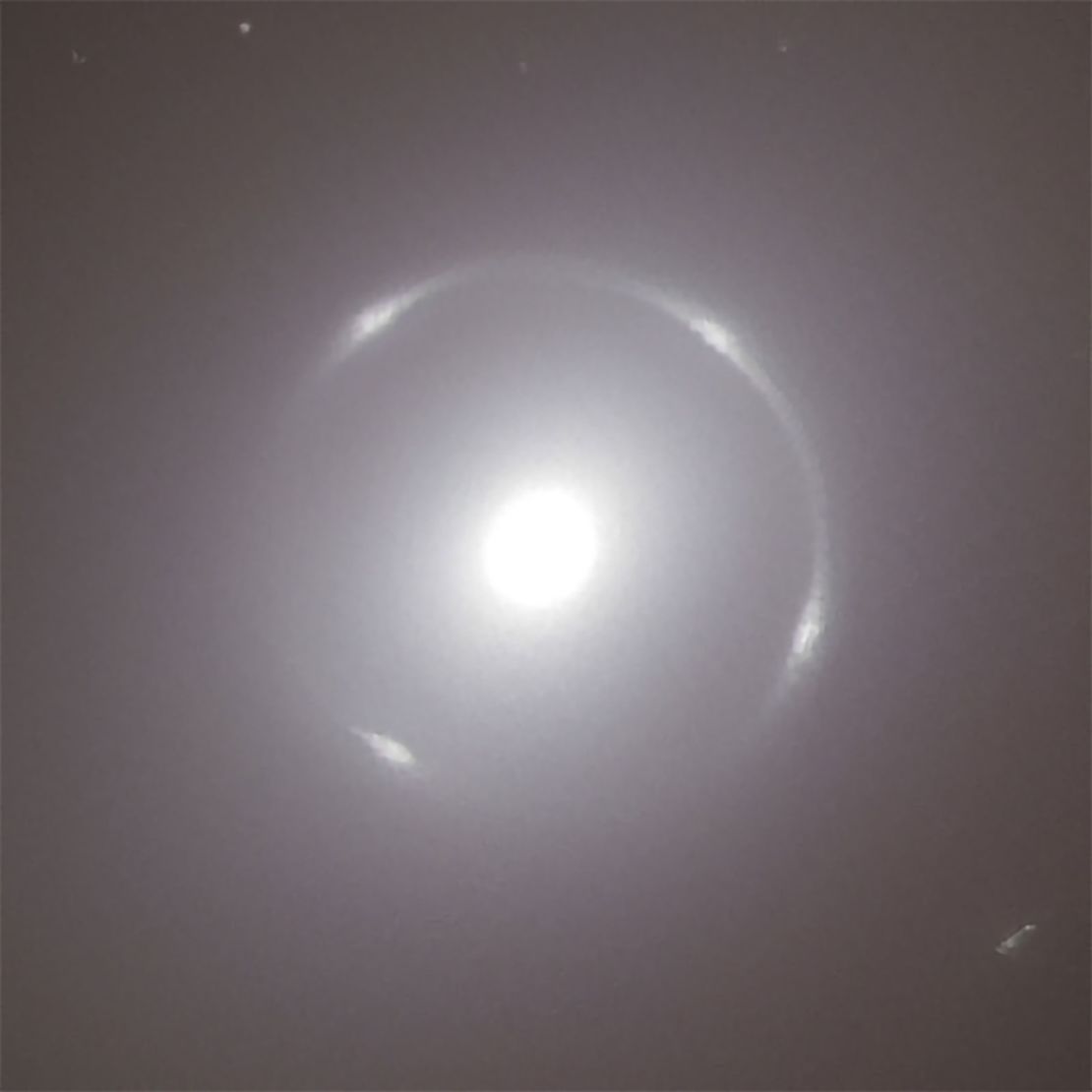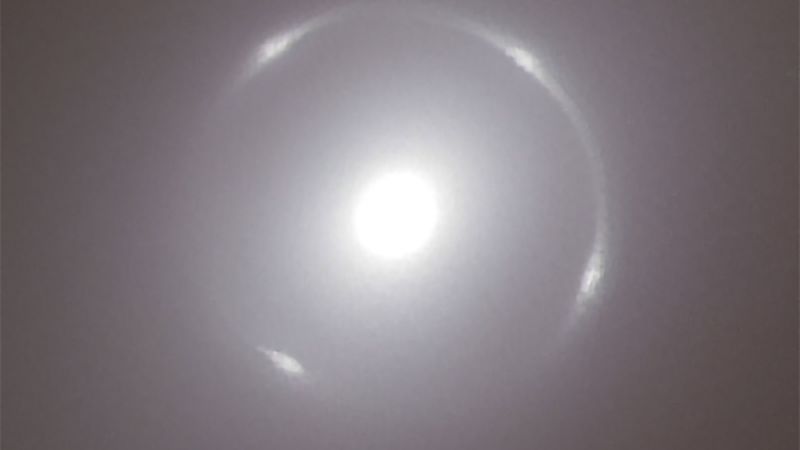Sign up for CNN’s Wonder Theory science newsletter. Explore the universe with news on fascinating discoveries, scientific advancements and more.
CNN
—
Astronomers with the European Space Agency’s Euclid mission have captured an unprecedented look at a rare cosmic phenomenon — and they made the observations purely by happenstance.
Their discovery is tied to some of the earliest data from the Euclid telescope, which launched in July 2023 to study the dark universe — the parts of the cosmos scientists can’t directly see — and spent the first few months calibrating and testing its instruments. When the test images were sent back to Earth, Euclid Archive Scientist Bruno Altieri spied what appeared to be an Einstein ring.
Einstein rings occur when light from a distant galaxy bends to form a glowing ring around another object in the foreground as that object is being observed. The rarely observed rings are named for mathematician and physicist Albert Einstein. His general theory of relativity predicted that light could bend and brighten around objects across the cosmos.
Euclid initially captured an image of a well-observed galaxy named NGC 6505, which is located about 590 million light-years from Earth, in 2023. A light-year is the distance light travels in one year, which is 5.88 trillion miles (9.46 trillion kilometers).
But for the first time, a ring of light has been revealed around the galaxy while using Euclid’s highly sensitive instruments. The ring itself is made of distorted light from a distant galaxy, located 4.42 billion light-years away. The galaxy, which has never been observed before, doesn’t yet have a name.
“I look at the data from Euclid as it comes in,” Altieri said in a statement. “Even from that first observation, I could see it, but after Euclid made more observations of the area, we could see a perfect Einstein ring.”
Now, researchers have made an in-depth study of the Euclid images showcasing details of the Einstein ring, published Monday in the journal Astronomy & Astrophysics. Understanding more about the phenomenon could help scientists to probe some of the enduring mysteries of the universe, such as dark energy — the enigmatic force that causes the universe to expand faster over time.
“I find it very intriguing that this ring was observed within a well-known galaxy, which was first discovered in 1884,” said study coauthor Valeria Pettorino, ESA Euclid Project Scientist, in a statement. “The galaxy has been known to astronomers for a very long time.
And yet this ring was never observed before. This demonstrates how powerful Euclid is, finding new things even in places we thought we knew well. This discovery is very encouraging for the future of the Euclid mission and demonstrates its fantastic capabilities.”
American astronomer Lewis Swift first observed the galaxy NGC 6505 in 1884, and it resembled a bright yellowish blob, with the detail of the ring obscured by the atmosphere, said lead study author Conor O’Riordan, a postdoctoral scholar at the Max Planck Institute for Astrophysics in Germany.
“By observing from space with Euclid, where there is no atmosphere to blur things out,” O’Riordan said in an email, “we are able to observe in great detail and reveal things like this which were hiding in plain sight.”
Einstein rings are examples of strong gravitational lensing, O’Riordan said, a phenomenon that acts like a magnifying glass in the universe, revealing celestial objects and light from distant galaxies that would otherwise remain unseen.
“When light from a distant galaxy travels through space on its way to Earth it typically travels on a straight path,” he said. “But if a massive object like another galaxy gets in the way, the immense gravity of the galaxy can actually bend the path of the light. This galaxy in the foreground acts like a ‘lens,’ focusing the light from the background galaxy into a distorted but highly magnified ring-shaped image of the background galaxy.”

In order to form an Einstein ring, multiple factors have to come together: A massive galaxy in the foreground needs to be perfectly aligned with the background galaxy from the perspective of the telescope.
It’s so rare that less than 1% of galaxies have an Einstein ring, O’Riordan said. There are between 100 and 1,000 Einstein ring-like objects known, but only a few tens of them have been observed at the level of detail provided by the Euclid telescope, he said.
While a distance of 590 million light-years sounds incredibly far from Earth, it’s nearby, astronomically speaking, the study authors said, which makes this one of only a handful of Einstein rings near our planet.
“The background galaxy in this lens is almost perfectly aligned with the foreground galaxy which is very rare indeed,” O’Riordan said. “This forms the spectacular complete ring you can see in the image. This rare alignment makes for an incredible image and reminds us how beautiful the universe can be.”
This particular Einstein ring will help astronomers essentially peer inside the distant, unknown galaxy so they can measure its mass and composition, how many stars it produced and how it has evolved over time, he said.
Astronomers are particularly interested in studying Einstein rings because they can be used to investigate dark energy as well as dark matter. While dark matter has never actually been detected, it is believed to make up 85% of the total matter in the universe.
“This dark matter doesn’t interact with light, but it does have a gravitational effect,” O’Riordan said. “Gravitational lensing therefore is sensitive to the presence of this dark matter, allowing us to indirectly detect it. For example, the size of the Einstein ring depends on the amount of mass in the galaxy. When we estimate the mass based on how many stars we see (how bright the galaxy is) we should see Einstein rings that are much, much smaller in size. It is only when we account for the missing dark matter that we can predict the size of the ring that we actually observe.”
Gravitational lenses like the newly detected Einstein ring can help shed light on what’s going on in the inner regions of galaxies, said Justin Spilker, an assistant professor in the department of physics and astronomy at Texas A&M University. Spilker was not involved in the new study, but has previously observed an Einstein ring using the James Webb Space Telescope that was described in a June 2023 study he coauthored with an international team of scientists.
“The size of the Einstein ring only depends on the total amount of mass near the center of the galaxy,” Spilker said in an email. “It doesn’t matter if that mass is made up of dark matter, stars, or cats — only the total matters! In this case, the researchers found that about 90% of the mass is stars, and about 10% dark matter (no word on the fraction in cats), which is pretty typical for the inner regions of galaxies.”
Euclid is on a six-year mission to observe billons of galaxies across more than a third of the sky. The 4-foot-diameter (1.2-meter-diameter) telescope’s primary goal is to observe dark matter and dark energy and to create the largest and most accurate three-dimensional map of the universe. And along the way, the telescope will likely increase the known number of Einstein rings by orders of magnitude, O’Riordan said.
“Euclid is going to revolutionize the field, with all this data we’ve never had before,” O’Riordan said. “We will have more Einstein rings than we could ever possibly work with, and this will bring its own new challenges.”
